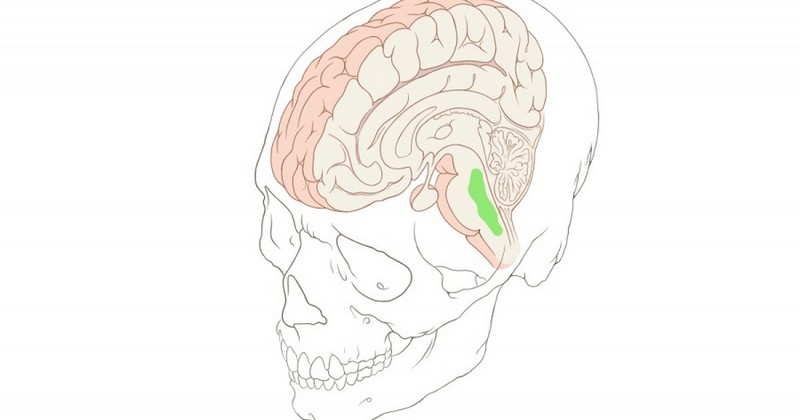Rafe nuclei: what they are and what function they have in the brain.

A part of the brainstem with important functions for our survival.
Serotonin is a brain neurotransmitter heavily involved in emotional regulation and aggressive behavior. The Rafe nucleilocated in the brainstem, is the area with more serotonin in the brain, and where it is secreted.
In this article we will know in detail these nuclei at anatomical level, their functions and how serotonin affects our behavior.
What are the Rafe nuclei?
The word "Rafe" comes from the Greek, and refers to a ridge that separates two symmetrical areas of an organ or tissue. The Rafe nucleus or nuclei is a group of neuron clusters found in the midline of the brainstem..
Specifically, the Rafe nuclei are a region of the human brain where serotonin, a brain neurotransmitter with an inhibitory effect on the brain, is synthesized and flows; serotonin acts on receptors located at the level of the amygdala and contributes to curb aggressive behavior. Its decrease implies an increase in the aggressive response in humans.
Thus, the serotonergic system originates in the Rafe nuclei; these nuclei form a wide organized network in the brain stem.
On the other hand, the Rafe nuclei are part of the reticular formation. are part of the reticular formationone of the most primitive areas of the brain, in charge of controlling sleep rhythms.
Where are they located?
Each of the serotonergic raphe nuclei is located next to the midline of the brainstem. Let's get to know this area of the brain:
1. Brainstem.
The Rafe nuclei are located in the brainstem. The brainstem is the region responsible for human "emotional reactions" and includes other structures such as the pons, cerebellum, reticular formation and locus coeruleus. In humans, these primitive structures remain active as vital warning mechanisms for survival. vital warning mechanisms for survival, and also for maintaining the sleep-wake cycle and respiration..
The brainstem, in turn, is made up of several very important areas such as the midbrain, the pons and the medulla oblongata. In addition to the above, it is also responsible for communicating the spinal cord and the nerves of the periphery with the different areas of the brain.
Functions of the nuclei
As we have already seen, the main function of the raphe nuclei is the synthesis of serotonin, the main neurotransmitter for the nervous system to function properly. Let's take a look at some of the most important functions of these nuclei:
Mood regulation: serotonin (SA) 2.
Serotonin regulates mood and does so by controlling negative emotions such as fear, aggression or anxiety.It does so by controlling negative emotions such as fear, aggression or anxiety. On the other hand, its lack or reduction can trigger disorders such as depression.
Once serotonin is synthesized in the Rafe nuclei, it is sent to the rest of the nervous system, where it fulfills its functions. Serotonin maintains and regulates mood and controls certain aggressive behaviors (also in animals). Some drugs, such as SSRIs (antidepressants), inhibit the reuptake of serotonin, causing it to increase its concentration levels in the brain; all this implies that depressive states improve (i.e., improve mood). This is why they are frequently used to treat depression (together with other serotonin enhancers such as tricyclic antidepressants, MAOIs, etc.).
On the other hand, we should know that the Rafe nuclei contain other types of neurons, not only serotonergic ones.
2. Sleep-wake cycles
The Rafe nuclei are also involved in the regulation of sleep-wake cycles.are also involved in the regulation of the sleep-wake cyclesworking in synchronization with the hypothalamus, with which they will provide feedback on the levels of alertness and wakefulness, consequently producing more or less serotonin.
3. Inhibition of pain
In addition, the Rafe nuclei (especially the nucleus magnus and the dorsal nucleus) are involved in Pain inhibition processes.
4. Aggressive behavior
As we have seen, aggressive behavior is related to the levels of serotonin (the more serotonin, the less aggressive behavior). Numerous structures are involved in the deployment and control of such behavior, such as the sensory systems (initially), the thalamus (which receives the information) and the amygdala (where the information culminates).
Anatomy of the Rafe nuclei
The Rafe nuclei are divided into six small nuclei. Some of them are located in the rostral region (closer to the upper brainstem), while others are located in the caudal region (the lowest region).
Specifically, 85% of the brain's serotonergic neurons are located in the rostral zone. This area is composed of the nucleus raphe pontis and the superior central nucleus, in the pons area, and the nucleus raphe dorsalis, in the midbrain area.
All these nuclei are connected to the areas of the brain where the higher functions are carried out. (such as frontal areas), although neurons of the nucleus dorsalis connect with numerous brain areas such as the orbitofrontal cortex or the hypothalamus (the latter controls the functioning of the nervous system, among other functions).
Bibliographical references:
- Calzada, A. (2004). Some aspects of interest on violence and child abuse. Rev Cubana Med Gen Integr; 20(5-6).
- Rosenweig, M.R.; Breedlove, S.M; Watson, N.V. (2005). Psychobiology: an introduction to behavioral, cognitive and clinical neuroscience. Barcelona: Ariel.
- Carlson, N.R. (2005). Behavioral physiology. Madrid: Pearson Educación.
(Updated at Apr 15 / 2024)